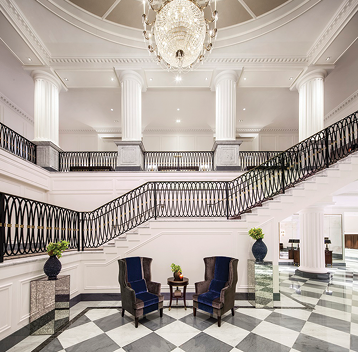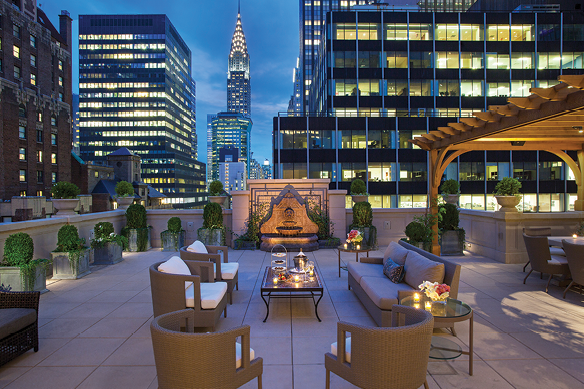- Home
- Media Kit
- Current Issue
- Past Issues
- Ad Specs-Submission
- Ad Print Settings
- Reprints (PDF)
- Photo Specifications (PDF)
- Contact Us


![]()
ONLINE

Modern Luxury
Editors’ Note
Kaila J. Pugliese joined the pre-opening team of the InterContinental New York Barclay in August 2015. Prior to this, she held various positions at Restaurant Associates, AlliedPRA and the iconic Waldorf Astoria New York where she served as Senior Sales Manager and then Director of Association Sales. She joined the renovated Barclay as Director of Group Sales and transitioned to Director of Business Development before assuming her current role in early 2019. Pugliese received her degree, cum laude, from West Virginia University and earned a Masters Certificate in Financial and Revenue Management from Cornell University School of Hotel Administration.
Property Brief
Since first opening its doors in 1926, the InterContinental New York Barclay (intercontinentalnybarclay.com) has welcomed guests to enjoy a luxurious residential-style experience in the heart of the city. Today, the property remains one of Manhattan’s preeminent luxury hotels. Combining sophistication and contemporary design, while staying true to its original Federalist style details, The Barclay exudes confidence and warmth, delivering the same residential feel with modern comfort and flexibility introduced to the world in 1926.

The Grand Staircase
How is the InterContinental New York Barclay positioned in the market and are you happy with the current product?
The thoughtfulness that went into every design element that was implemented during the two years the hotel was closed for renovation was remarkable.
As we move into our third year of being open following the renovation, we’re in a very good position. Last year was a huge success from a financial standpoint, from a service standpoint and from an employee standpoint. We exceeded all of our benchmarks. We have set the bar even higher for this year and have identified how we intend to elevate each element to bring The Barclay to the next level.
How broad is the target market for The Barclay?
Today, we’re seeing our older generation of guests traveling with the younger generation, and that is where we have hit it out of the park.
We have history – we’re luxury, but we’re not stuffy luxury. We’re modern luxury and are attracting the young traveler who wants the technological touchpoints and a sexy, more modern feel, while making sure we can accommodate the service and product expectations of our older, distinguished clientele.

View of the Chrysler Building from the Penthouse Terrace
Is your competitive set mainly Midtown East properties or is it broader?
It is definitely broader today, especially with technology opening access. I don’t think travelers today identify a certain area or a certain property they want to stay in.
This means that we compete with some of the big boxes that are more traditional conference hotels, but we also compete with luxury, high-end, boutique properties.
It speaks back to how the hotel was originally built in 1926. We continue to evoke that residential feel. The lobby is very intimate, yet we have 703 rooms and 20,000 square feet of meeting space that the independent guest may not even be aware of.
This provides us with a lot of opportunity.
How important is the suite offering at The Barclay?
We have fewer suites than we did prior to renovation. We used to have 86 and we now have 29 plus our specialty suites.
Today, it’s very important that our clientele generate a buzz, also known as the Instagram effect. Our specialty suites are critical for this.
We have a Penthouse Suite with a 1,200-square-foot outdoor terrace and a Presidential Suite, which are our premier suite products. Our standard suites are also very beautiful and residential.
Occupancy of the suites has doubled over the past two years, and now we’re looking to do more VIP client events in the suites, which generates more guest involvement and interaction, also opening more opportunities to invite in our nearby clientele for a unique experience.
New York City is very competitive from a food and beverage standpoint. Will you highlight this area for The Barclay?
It’s definitely important and not just how it looks and tastes, but also how it makes you feel.
Our food and beverage outlet extends on our residential feel. Certain of the younger generation wants to be immersed in New York City and its culture, so we work to evolve that into our food and beverage offering.
Our Executive Chef, Peter Betz, was previously with The Waldorf and has done tremendous things in bringing those local New York City staples in and incorporating them into our catering and banquet programs, as well as our food and beverage outlets at The Gin Parlour.
There are many new, exciting developments coming in this area in the next few months, with special attention on increasing our local partnerships.
With the focus today around health and wellness, how important is it to have a spa offering and an updated fitness facility?
We have to offer those amenities and accommodations if we want to play in the luxury space. We don’t need to have a 2,000-square-foot gym, but the products we have in the gym and services we are able to provide from a concierge level – be it a private trainer or yoga on the roof – have to be top-notch. We will be incorporating additional partnerships as we move into 2020, which will enhance our offerings.
How challenging is it to control your messaging today with social media and sites like TripAdvisor?
There is much less control and everyone thinks they are a critic at this point, and they are – our guests are our number one stakeholders. We have to make sure that each one of them is looked after and that we fully address any concerns as soon as we receive them.
It is critical that we cascade our messages and drive it through all of our touch points from Instagram to TripAdvisor to social media to guest arrival to when they’re in the room through departure. It is essential to make sure we are cohesive and addressing that full circle.
With booking windows becoming shorter, is it more difficult to forecast and budget for the future?
It’s extremely challenging. I anticipate that this will continue to be a trend. The best that we can do is to educate and communicate and make sure the team knows where we stand at all times. We want to make sure they appreciate the positioning and what metrics we have to achieve and then empower them to make the decisions necessary to deliver those results.![]()